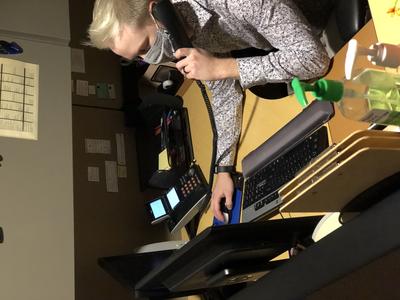
They have quickly become detectives in the war against COVID-19.
Wright State University Boonshoft School of Medicine (BSOM) students say conducting contact tracing of people testing positive for the virus has been challenging but underscores its importance in limiting the spread of the pandemic.
“Being a part of a team actively trying to help our community has really shown me how crucial public health is and how it deserves a lot more government funding,” said Leah Elliott. “Without the public health infrastructure and systems in place, this virus would have been much more deadly.”
Elliott is one of BSOM Master of Public Health (M.P.H) students serving as contact tracers and supervisors of student contact tracers for five Ohio counties.
Contact tracing is an effective disease control strategy that involves identifying cases and their contacts, and then working with them to interrupt disease transmission.
The role of the M.P.H. program is to contact people in Warren, Butler, Preble, Miami and Champaign counties who are infected with COVID-19 or who have been in close contact with someone who was infected. Those contacted are asked who they have been around and if they can quarantine safely. Data and information collected on positive cases is entered into the Ohio Disease Reporting System and the Ohio Contact Tracing System.
Elliott is a graduate assistant in the M.P.H. program, and became involved with the contact tracing team in July. In early September, she began contact tracing in Butler County.
“It is an excellent experience and I truly believe I wouldn’t get this anywhere else other than Wright State,” she said. “I manage six to 10 contact tracers during any given shift, and this experience has improved my management and organizational skills and has enabled me to work on an inter-professional team.”
Kyle R. Henneke, an M.P.H. student and third-year medical student in BSOM’s Physician Leadership Development Program, is responsible for recruiting, training and monitoring the medical students involved with the program. He also developed the COVID-19 informational part of the training and helps train incoming contact tracers in motivational interviewing.
The students received seven hours of training, using the Johns Hopkins University COVID-19 Contact Tracing Module, an online course that introduced students to the science behind the virus and how it spreads. An additional three hours of in-person training was required for navigating Microsoft Teams, workflow, expectations, COVID-19 facts, motivational interviewing skills and mock interviewing.
Henneke worked as a travel nurse in an emergency room in New Orleans during the first two months of the pandemic, helped with an Ohio State University field study for six weeks by testing K–12 students, and currently helps Greene County with its COVID-19 vaccinations.
“Contact tracing has been very different for me, as it requires a different skill set. It requires patience and providing lots of education to the public,” he said.
Henneke said a big challenge with contact tracing is rumor control. They try to help people overcome the misconceptions and myths about the virus.
“When calling people to talk to them about symptoms and guide them through isolation and quarantining measures, there’s a lot of push-back,” he said. “Calming people down can be difficult. In addition, helping the contact tracers work through these issues is challenging.”
Henneke said some people who test positive for COVID-19 can be unpredictable when contacted, even when the contact tracers have done the necessary research and covered all the bases.
“I tell the contact tracers they should approach every shift ready for something new. Every situation is unique,” he said.
Elliott said some people contacted after testing positive for COVID-19 refuse to isolate or quarantine because they believe the virus is a hoax, it is not that serious, or they don’t believe they have COVID-19 because they are asymptomatic.
“I have also experienced people who are unable to isolate or quarantine because they need to work to support themselves or their family; therefore it is important to connect them with as many resources as possible,” she said.
Natalie Hicks, a first-year M.P.H. student, jumped at the chance to be a supervising contact tracer because she wanted to be involved in helping local communities mitigate the effects of the pandemic.
“Our process changes daily and really requires a dynamic team willing to switch things up to make sure we meet the needs of local epidemiologists, health commissioners and other public health figures,” Hicks said.
The M.P.H. program is part of the Department of Population and Public Health Sciences, which has a close relationship with many of the surrounding health districts and is directing the contact tracing support program.
The contact tracing program is directed by Camille Edwards, M.P.H., with support from faculty and department chair Marietta Orlowski, Ph.D., and Sara Paton, Ph.D., faculty and director of the M.P.H. program.
M.P.H. students also helped administer COVID-19 vaccines in Greene County, working with Dr. Gregory Toussaint, assistant dean for Clinical Skills Education, at a pop-up site that serves adult care centers run by the Ohio Department of Developmental Disabilities (DODD).
M.P.A. student Colleen Pennington, a second-year medical student and a medical technician in the Vermont Air National Guard, said she and the other vaccinators set up in a small room. As the individuals and their caregivers came in, they were able to talk with them and take the time each person needed to receive their vaccine. She said between 60 and 70 people were vaccinated during one session.
“We have the pleasure of vaccinating the DODD population in this area as well as staff and caregivers,” added Henneke, who also ensures that those vaccinated understand the potential side effects and when to return for their second doses. “It has been extremely rewarding work. Working with Greene County Public Health to get our health care providers and those at higher risk vaccinated has been awesome.”
—Jim Hannah

